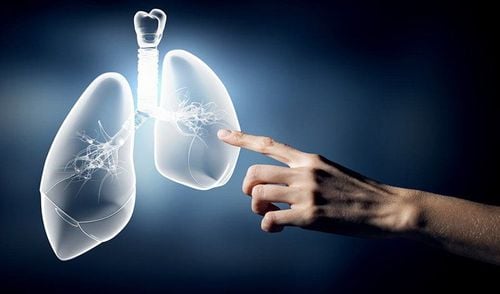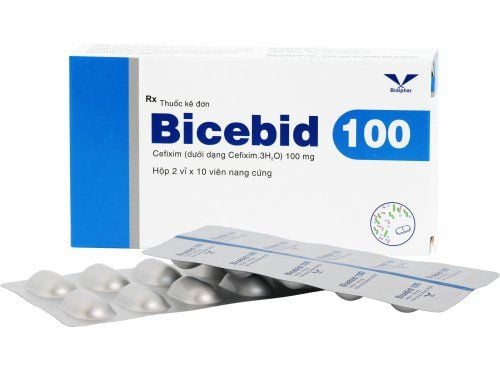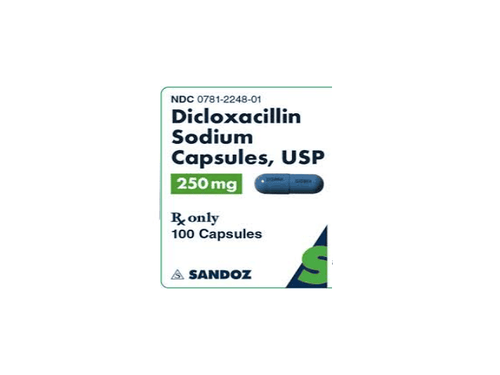This is an automatically translated article.
Amoxfap has the main ingredient Amoxicillin, which is an antibiotic belonging to the Beta - Lactam group. The drug is commonly used in the treatment of infections in the respiratory tract, urinary tract, ear, nose and throat, teeth and gums, etc. caused by sensitive bacteria. Information about the uses, doses and side effects of Amoxfap medicine will be in the following article.
1. What is Amoxfap?
Amoxfap drug is prepared in the form of powder for oral suspension, with the main ingredient being Amoxicillin in the form of Amoxicillin trihydrate compacted 500 mg in each 3 g pack.
Amoxicillin is a semi-synthetic penicillin, belonging to the group of beta-lactams with bactericidal action. The drug works by inhibiting Peptidoglycan biosynthesis, preventing bacterial cell wall formation by binding to one or more penicillin proteins of the bacteria. As a result, bacteria that do not form cell walls will self-destruct.
Amoxacillin has some characteristics such as:
Acts like Penicillin G on gram-positive bacteria, but has additional effects on some gram-negative bacteria including: E. coli, Proteus mirabilis, Salmonella, Shigella, Haemophilus influenzae Destroyed by penicillinase Not destroyed by gastric juice Compared to another drug in the same class, Ampicillin, Amoxicillin is more effective against Enterococcus faecalis, Salmonella and Helicobacter pylori but less bactericidal against Shigella and Enterobacter.
Currently, Amoxicillin has a high rate of oral absorption, so the oral form is preferred over the injectable form, especially in respiratory tract infections. Thanks to its more complete absorption from the gastrointestinal tract, the concentration of Amoxacillin in serum and in infected organ tissues will be higher, increasing the effectiveness of treatment, reducing the frequency of drug use and the occurrence of side effects. than.
2. What are the effects of Amoxfap?
Amoxfap is indicated for the treatment of:
Ear, nose and throat infections: pharyngitis, tonsillitis, sinusitis, otitis media Respiratory tract infections: bronchitis, lobar pneumonia, bronchial pneumonia Urinary tract infections: pyelonephritis, cystitis Obstetric and gynecological infections In case of meningitis, endocarditis, bacteremia caused by drug-sensitive bacteria: should be used parenterally and in combination with Another antibiotic Prophylaxis of infective endocarditis Amoxfap is contraindicated in cases where people have a history of allergy to Amoxacilin, other antibiotics of the Beta Lactam group or Cephalosporins.
3. Dosage and how to use Amoxfap
3.1. Dosage Adults or children over 40 kg: Usual dose: 750mg - 3g/day, divided into 3 doses
Children under 40 kg: 20 - 50 mg/kg/day, divided into several doses.
3.2. How to take Amoxfap is taken orally. Patients mix 1 pack of medicine with a moderate amount of water into a suspension and use it immediately. For children under 6 months of age, a dropper suspension should be used. Amoxfap should be evenly spaced between doses so that the drug concentration in the blood is always sufficient to kill bacteria.
4. Notes when using Amoxfap
4.1. Side effects encountered when using Amoxfap The side effects of the drug are not common and are mild and of a short duration. However, some patients during treatment with Amoxfap may experience side effects such as:
Hypersensitivity reactions: itching, skin rash, urticaria; erythema multiforme, bullous dermatitis, toxic epidermal necrolysis, acute generalized pustulosis, and Stevens-Johnson syndrome. Anaphylactic reactions: Quincke's edema, serum sickness, hypersensitivity vasculitis; Interstitial nephritis Gastrointestinal: Nausea, vomiting, diarrhea; Intestinal candidiasis, colitis Liver: hepatitis, obstructive jaundice Hematology: leukopenia, thrombocytopenia, hemolytic anemia, prolonged bleeding time. Nervous: hyperactivity, dizziness, convulsions, especially in people with kidney failure When side effects appear during the use of Amoxfap, the patient or family member must notify the doctor or go to a medical facility to treated appropriately.
4.2. Notes on the use of Amoxfap in subjects Caution should be taken when using Amoxfap in people with mononucleosis due to viral infections with symptoms of fever, fatigue, sore throat, swollen neck lymph nodes. Caution should be exercised in patients with renal impairment because the drug is eliminated primarily in the urine. It is necessary to adjust the therapeutic dose or extend the interval between doses and monitor patients when prescribing Amoxfap in these subjects. Be cautious about the dose and administration of Amoxfap in infants and children. Closely monitor the patient if Amoxfap is used together with anticoagulants. Patients need to take the full dose and number of days indicated in the Amoxfap prescription, do not arbitrarily stop taking the drug when the symptoms have improved. It is important to drink a lot of water during Amoxfap treatment because less urination increases the risk of drug crystallization. Pregnancy: There are no studies showing that Amoxfap is safe for use in pregnant women. Therefore, do not use the drug unless absolutely necessary and consider the benefit/risk ratio Lactation: Studies and clinical trials have shown that Amoxacillin is excreted in human milk with Because a very small amount is safe for the infant at usual doses, Amoxfap can be used in nursing mothers and requires close monitoring of the dosing process.
5. Amoxfap drug interactions
Do not use Amoxfap at the same time as the following drugs because of the risk of drug interactions:
Oral contraceptives Allopurinol Probenecid Above is basic information and important notes when using Amoxfap. Amoxfap is a prescription medication and should only be used as directed by your doctor. Patients should consult with their doctor or pharmacist if they have any questions in order for the Amoxfap treatment process to be most effective.













